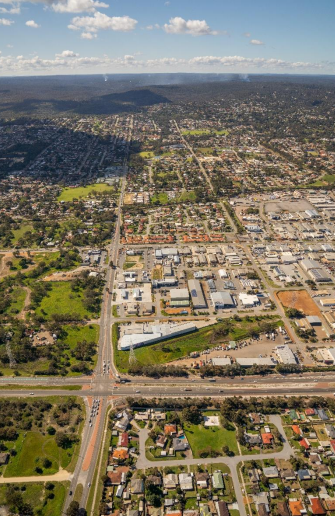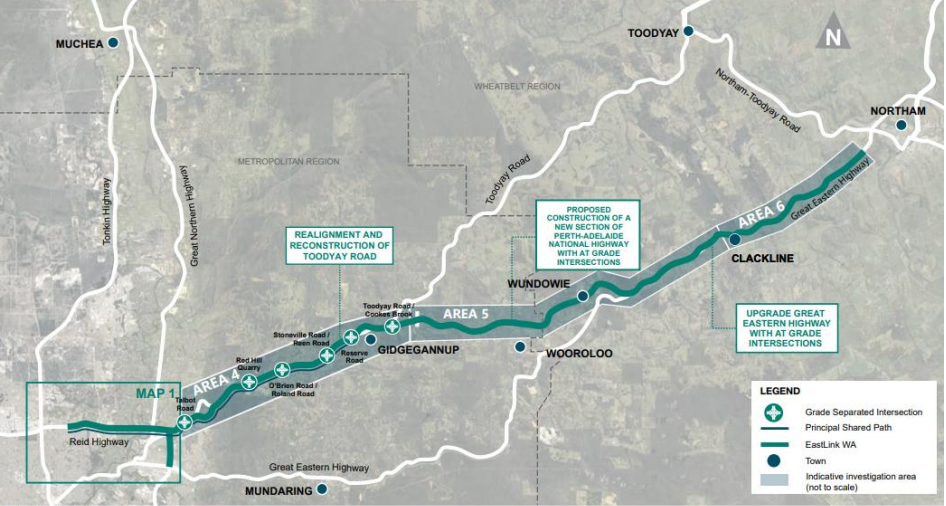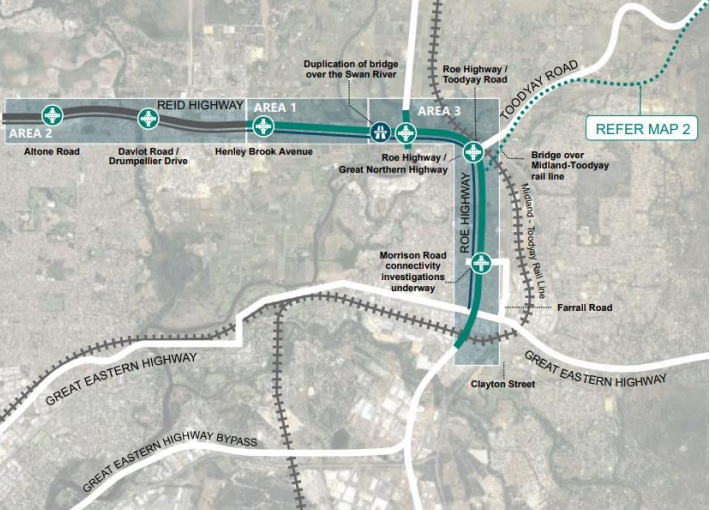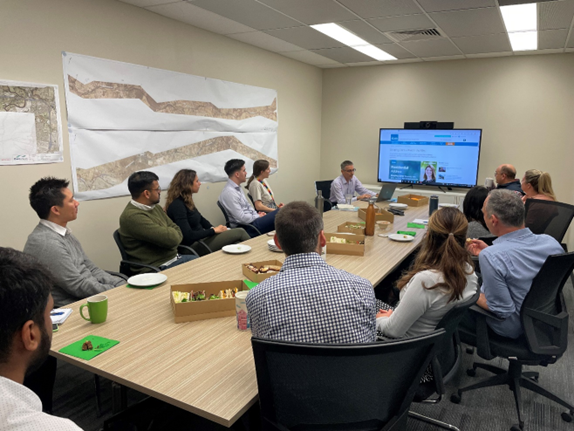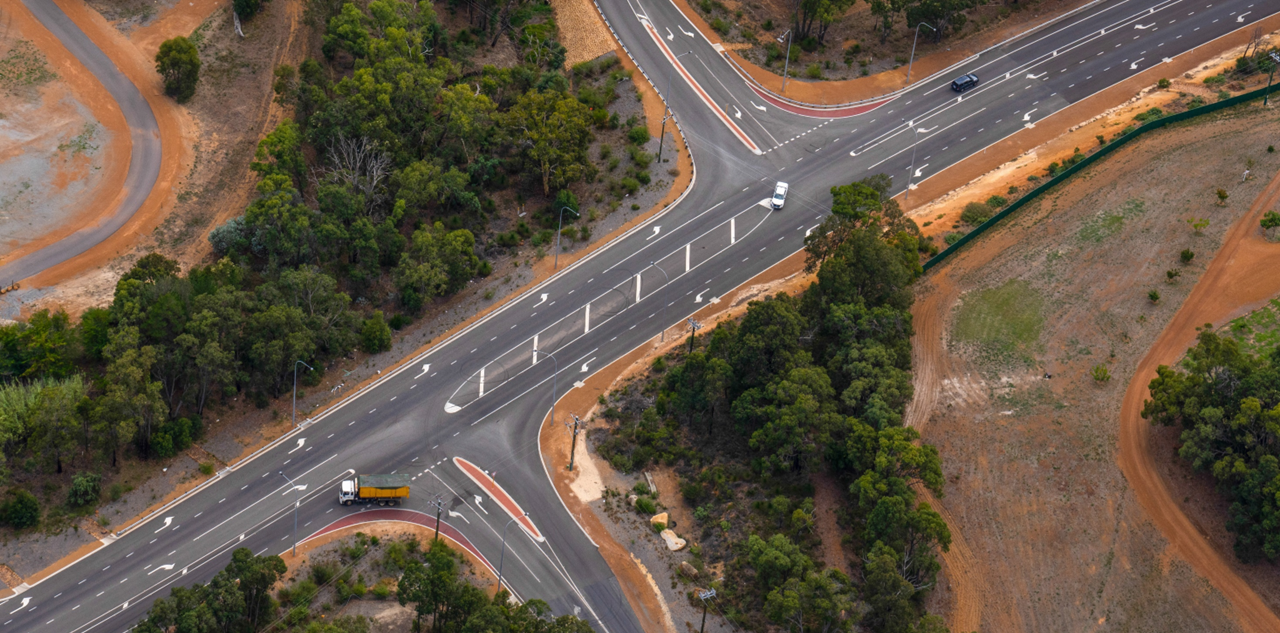EastLink WA – Governance Outcomes
Describe WHAT you have done and HOW you have done it.
EastLink WA’s planning and development approach embodies a holistic sustainability vision, to achieve social-economic benefits for the community. To realise this vision, the Integrated Project Team (IPT) developed an industry-leading Decision-Making Framework to guide decisions throughout the project. The Framework prescribes various levels of decision-making involvement and governance depending on the magnitude of the decision.
EastLink WA is the largest planning and development project undertaken by Main Roads, encompassing planning for over 80km of road infrastructure over a three-year period. In a project of this scale, sustainability can easily be sidelined or addressed too late in the process. The IPT recognised that decision-making during initial stages of design offers the greatest potential to influence project outcomes and took the opportunity to integrate sustainability considerations from the outset, through the Decision-Making Framework.
The IPT was committed to implementing not only the best technical options in project planning, but to develop options based on a robust understanding of their environmental and social context. To integrate sustainability considerations effectively, the IPT aligned with the design team’s processes and timeframes and addressed key decision-making challenges associated with planning projects, including the evolving nature of information and need to consider multiple factors in decision-making, and decision-making documentation for future review.
The Framework addressed these challenges and ensured consistent consideration of social, environmental, urban design, economic, and sustainable solutions. This framework is based on a six-step process for developing and selecting preferred design options. The steps include problem identification and definition, and options identification, assessment, and testing.
Tools adapted from the Main Roads Multi-Criteria Assessment template for planning phase decisions were used to guide options assessment through rapid assessment of criteria across equal weighted technical, economic, environmental, and social aspects. The decision-making tool also included whole-life considerations when they were deemed important differentiators for the options.
The EastLink WA Decision-Making Framework clearly outlines involvement of stakeholders at different stages of the governance process in developing, assessing, and making decisions on preferred design options. To prioritise decision-making, the framework categorised decisions into three levels of significance: level one (minor), level two (medium), and level three (significant). Depending on the significance level, input and involvement from the broader team, Main Roads WA, and external stakeholders, were sought accordingly.
A robust governance sign-off process was also applied via the Framework, with more significant decisions brought to the Project Advisory Group or Steering Committee for endorsement, dependent on level of significance.
The Framework was developed based on the collective experience of the IPT and Main Roads across various planning and development projects. To generate buy-in for implementation of the Framework in the project, the IPT’s sustainability team drafted and tested the Framework with the design team on some early project decisions. An internal workshop with IPT discipline leads was conducted to reflect on lessons learned and refine the Framework for further application.
For transparency and guidance in future project stages, decisions have been recorded and maintained in a dedicated EastLink WA project decision-making register, outlining who the ultimate decision-maker was.
What were the OUTCOMES and how were those outcomes shared?
The Decision-Making Framework aimed to provide guidance throughout the project, considering all relevant aspects - including technical, social, environmental, and economic factors - across the project lifecycle. As a result, decision-makers have greater clarity on preferred options, and the documentation enables effective review of decisions, if necessary, in future project phases.
The Framework streamlined the decision-making process for the IPT by clarifying the necessity, significance, and scope of decisions, involving relevant specialists, and minimising the risk of future re-work. It efficiently manages and documents sustainability-related risks throughout the project lifecycle.
EastLink WA has achieved a range of outcomes from applying the Framework. Three notable alignment decisions that achieved positive outcomes are outlined below.
Susannah Brook (environmental benefits)
The IPT explored two options for the road alignment in proximity to heritage-listed Susannah Brook. Previous planning impacted approximately 2km of a tributary of the brook and did not allow for required service road connections to meet bushfire requirements.
Despite land-use planning constraints in the area, the IPT developed an alternative solution that shifted the alignment south. The solution minimised impacts to Susannah Brook by retaining ~1.4km of the existing tributary, avoiding waterway diversion. The remaining impacted section will be designed as a “living stream”. This design modification has led to positive outcomes from environmental, waterways and Aboriginal Heritage perspectives.
Bakers Hill (social/environmental benefits)
The originally proposed alignment identified in previous planning would have resulted in several significant impacts in proximity to Bakers Hill, including impacts to the Kep Track, a local trail of important social value, residential properties and dwellings, local access and connectivity, and remnant vegetation. Many of these impacts were identified through consultation with local landowners and wider stakeholders, including LGAs.
The IPT considered two alternative alignment options to reduce identified impacts and address stakeholder concerns. Following the project’s six-step option development and selection process, a preferred option was developed.
While the option developed and agreed upon as the preferred alignment was found to be more resource and cost intensive, it delivered a range of social and environmental benefits which addressed many of the stakeholder concerns, including:
• Significantly reduced clearing of remnant vegetation (~3ha).
• Avoiding impacts to ~7.5km Kep Track between Chitty Road and Clackline.
• Reducing impacts to an Aboriginal heritage site.
• Improving network efficiency by creating two-way access for properties north of the Perth Adelaide National Highway (PANH).
• Improving safety by reducing the number of intersections and local trips on PANH.
Altone Road (social – urban design benefits)
The grade separation of Reid Highway and Altone Road in the metropolitan section of the project is adjacent to and provides access to residential areas. Previous planning included Altone Road passing over Reid Highway. Design development of the Altone Road interchange identified several design and constructability outcomes that could be improved by reconfiguring the interchange so that Reid Highway passed over Altone Road.
Considering multi-disciplinary input from the IPT, the merits of the two options were assessed. The decision to update planning to reconfigure the interchange to include Reid Highway passing over Altone Road was based on several community amenity advantages, including:
• Significantly reduced utilities impacts and improved potential to stage any future upgrade requirements.
• Likely allowing Altone Road to remain open and connected during construction.
• Limiting visual impacts for adjacent residents by having the nearby local roads on the ground.
• Retaining connectivity for local roads and path connections.
Positive outcomes associated with the use of the EastLink WA Decision-Making Framework have been shared in several forums including the ISC WA Symposium (April 2023) and at the Office of Major Transport Infrastructure Delivery (OMTID) quarterly industry knowledge share session (May 2023) . These sessions included industry representatives from government departments, consultancy and construction firms.
Two members of the IPT presented a 90-minute session on ‘Integrating Sustainability into Project Level Decision Making’ as part of the Institute of Public Works Engineering Australia’s (IPWEA) Professional Development Week in December 2022. The accompanying teaching paper outlined general examples from several projects and integrated several lessons learned from EastLink WA.
EastLink WA’s use and sharing of the Decision-Making Framework has led to beneficial industry outcomes by challenging the wider industry through sharing examples, experiences and lessons learned.
Describe WHO benefited from your initiative, innovation, or approach?
Planning and development decisions have the potential for long-lasting implications across the project lifecycle. The development and adoption of the EastLink WA Decision-Making Framework has provided a range of benefits to stakeholders, including:
• The EastLink WA IPT, who have benefited from efficiencies created through the streamlined decision-making process and learnings gleaned from the Framework’s application that can be applied to future projects.
• Main Roads WA, who have benefited from optimised project outcomes from strong sustainability integration and clear decision-making that builds a robust foundation for future project phases. Project outcomes have been enhanced by the framework’s creation of a streamlined platform that has allowed IPT discipline leads to apply their technical skills collaboratively to identify multiple options for consideration and assessment. Significant learnings have also been gained from EastLink WA’s approach to sustainability that can be applied to enhance outcomes on future planning and development projects.
• Community and directly affected landowners, who have benefited from the project’s emphasis on stakeholder engagement and strong systems and processes for capturing and considering stakeholder feedback and input within the Decision-Making Framework. A consistent community and stakeholder engagement program provided a platform for community and landowners to share their insights and feedback for consideration in design development and remain updated on the project’s progress. As a result, the design reflects a number of positive outcomes for directly impacted landowners - and from a broader environmental, social, economic and urban design perspective - where feedback has been considered and effectively integrated into the Ultimate Design.
• Wider industry, who have benefited from the IPT sharing knowledge based on the EastLink WA approach and governance frameworks. EastLink WA sets a benchmark for other planning and development projects and highlights integrative and innovative approaches to enhance project outcomes.
What LEGACY and UN SDG CONTRIBUTION was achieved?
Fundamental to the IPT’s approach to design development is considering long-term needs to create more sustainable and resilient infrastructure. The development, application, and improvement of the Decision-Making Framework has resulted in the creation of significant legacies, including:
Transferable experience: The project team have gained valuable experience applying the Framework, which can be used on future projects. Although a new practice for many team members at the start of the project, as the project progressed, the design team proactively sought input from environment, stakeholder, sustainability, and urban design managers as a standard practice. The success of the Framework has also led to its informal sharing within several other Main Roads WA projects and can be applied to all future Main Roads planning projects.
Integrated environmental and stakeholder benefits: The project design now incorporates and prioritises environmental and stakeholder considerations, which will carry forward into future phases, creating a lasting legacy. By addressing potential impacts early in the planning phase, many adverse impacts have successfully been avoided or mitigated. This early action benefits not only the environment and the community, but also reduces reputational risks, risks associated with approvals, and potentially lowers the cost of impact management.
The project implemented a systematic approach that provides benefits to the community, minimises impacts on Aboriginal heritage sites, reduces clearing of remnant vegetation, improves connectivity, and provides clarity on decision-making processes.
Drawing from this project experience (and previous projects), the IPT presented a 90-minute masterclass and teaching paper on ‘Integrating Sustainability into Project Level Decision-Making’ to the Institute of Public Works Engineering Australia (IPWEA). The IPT’s decision-making approach and knowledge sharing contribute to responsive, inclusive, participatory and representative decision-making at all levels, as per SDG 16 (Peace, Justice and Strong Institutions).
For SDG 16 target 16.7, the framework guided the process and documentation throughout the project, facilitating the consideration and integration of social, environmental, and economic factors. A lessons learned workshop with IPT discipline leads encouraged co-design of the project’s processes and tools.
The project contributed to SDG 9 (Industry, Innovation and Infrastructure), specifically target 9.1, to develop quality, reliable, sustainable, and resilient infrastructure, as well as providing redundancy for surrounding links on the network. Planning and development for EastLink WA seeks to provide a safer, more efficient route between Perth and Northam for freight and road users by providing a high standard, fit for purpose, alignment. It encompasses planning for the first section of the Perth-Adelaide National Highway, a transborder freight corridor with strategic state importance. The planning has also incorporated a climate change risk assessment process, leading to robust resilience outcomes. Design decisions prioritised reducing service impacts, visual impacts, and maintaining and improving connectivity with infrastructure that will meet WA’s future freight needs.
The project contributed towards SDG 11 (Sustainable Cities and Communities), including targets 11.2 (safe, affordable, accessible and sustainable transport systems), 11.4 (cultural and natural heritage), 11.A (support economic/social/environmental links between urban, peri-urban and rural areas) and 11.B (integrated policies and plans). The Decision-Making Framework resulted in design development that enhances safety, accessibility, and a sustainable transport system. This includes reducing intersections, improving network efficiency, and creating two-way access for residential properties. The project has supported positive economic, social and environmental links evidenced by opportunities identified to retain and protect the Kep Track, a local trail which traverses these landscapes and is of significant social value. The framework enabled evaluation of options to protect and retain the ‘living stream’ and adopted an updated road alignment to reduce the impact on the Susannah Brook tributary. The preferred alignment option selected at Bakers Hill also reduces impacts to an Aboriginal heritage site.
[embed]https://vimeo.com/845200922?share=copy[/embed]

